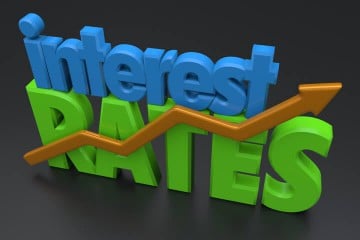An interest rate refers to the price of borrowing funds or the return on savings. The interest rate is calculated as a % of the borrowed or saved amount.
Certificate of deposit (CD) or savings account earnings at a credit union or bank may also be subject to an interest rate. Annual percentage yields (APY) measure the interest received on these deposit accounts.
When you obtain a home mortgage, you borrow money from banks. You can use other loans to finance your schooling, purchase an appliance, or get a car. Banks use your deposits as collateral for loans and reimburse you for using your deposits with interest. They fund loans using money from deposits.
Banks offer significantly higher interest rates to borrowers than to depositors. Their profit makes a difference. Interest rates stay within a limited range because banks compete with one another for both borrowers and depositors.
How does Interest Rate Work?
Interest is a fee charged to the borrower for the use of a commodity or an asset. Borrowed assets may include money, merchandise, automobiles, and real estate. Since higher interest rates make lending the same amount of funds more expensive, they can be seen as the "cost of money."
You must pay nearly the interest in each compounding term which is calculated by the bank using the total amount owed on your debt or credit card balance. If you are making payments, your total debt will stay the same.
Although interest rates are highly competitive, they are not identical. A bank will charge a higher interest rate if it believes the debt will not be repaid. As a result, because revolving loans, such as credit cards, are more expensive to manage, banks typically charge a higher interest rate. Banks also charge higher interest rates to people they perceive risky. In other words, the better your credit rating, the lower your interest rate.
Types of Interest Rate

Fixed interest rates, variable interest rates, annual percentage rates (APR), discounted interest rates, and simple and compound interest rates are the most common types of interest.
- Fixed Interest Rate
The most typical type of interest rate assessed to the loan borrower by lenders is a fixed interest rate. As the name implies, the interest is fixed for the loan's payback period.
A fixed interest rate doesn't change over time or during the loan term and aids in providing the borrower with an accurate estimate of future payments.
When the loan is approved, it is often decided by mutual consent between the borrower and the lender. Calculations for fixed interest rates are a lot simpler.
- Variable interest rate
The prime rate of interest, the movement of the base level of interest rate, affects the variable interest rate. Your loan payment will increase if the rate does. When taking out one of these loans, you must be aware of the prime rate, which depends on the federal funds rate. With either kind of loan, you can often make a larger-than-required additional payment to the principal at any time, which will help you pay off the debt sooner.
- Simple Interest Rate
A simple interest rate refers to the interest rate a bank charges its customers. The formula for the calculation of a simple interest rate is as follows;
Simple interest rate = Principal x Interest rate x time
For example, a bank charges 5% interest on a loan of $2000 for two years. The calculation of the simple interest rate formula stands to be; $2000 x 5% x 2 = 200
- Compound Interest Rate
A compound interest rate is also known as the interest-on-interest approach. Banks typically use the calculation to determine bank rates. It is based on the principal amount and the loan's interest rate, which are both important factors.
Here, banks would first apply the interest rate to the loan balance, and any outstanding balances will utilize the same amount to determine the interest payment for the following year.
- Annual Percentage Rate (APR)
In credit card firms and payment methods, annual percentage rates (APR) are used frequently. The outstanding interest amount is divided here by the entire loan cost to determine the annual interest rate.
This procedure is used by credit card companies when clients carry a balance forward rather than paying it off in full. The prime interest rate, which is calculated as the annual percentage rate, is also multiplied by the margin that the lending institution assesses.
How to Determine an Interest Rate
The fed funds rates or Treasury note yields are used to calculate interest rates. The Federal Reserve determines the fed funds rate as the benchmark for short-term interest rates. For overnight loans, banks charge one another the fed funds rate.
Demand for U.S. Treasury notes influences Treasury note yields. Treasurys are items that are auctioned off. Investors fork over more money for the bonds when demand is high, and their yields are thus reduced. Interest rates on long-term securities, such as 15 and 30-year mortgages, are impacted by low Treasury yields.
APR Vs. APY

Annual Percentage Rate (APR) refers to the consumer loan interest rates. To borrow their money, lenders entail a certain rate of return. An APR quotes credit card interest rates, and it does not consider compound interest for the year.
The interest rate earned on a savings account or certificate of deposit (CD) at a bank or credit union is known as the annual percentage yield (APY). APY considers the interest rate.